Development, investment priorities set for Little Village
By Igor Studenkov For Chronicle Media — May 28, 2024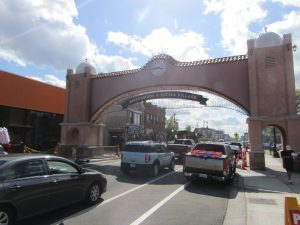
The iconic “Welcome to Little Village” arch on 26th Street
Chicago’s Little Village neighborhood, the heart of the city’s Mexican-American community, is getting its third Quality of Life Plan — and this time, the nonprofits that steered its development are more determined than ever to make sure it bears fruit.
The Quality of Life Plans are meant to provide a unified vision for, as the name suggests, improving the quality of life of life in a specific neighborhood by setting goals and priorities that would guide future improvements, investments and developments.
Over the last 20 years, they were developed for many Chicago communities, mostly the ones on the city’s South and West sides. The plans are not legally binding, but city planners tend to take them into account, and it’s not unusual for private developers to reference them when asking for city funds and/or zoning changes.
The development of all three Little Village Quality of Life plans were spearheaded by Enlace Chicago, a local nonprofit that advocates for economic and social advancement. Cesar Nunez, the organization’s co-director, said they plan to form a committee that will regularly check on the plan’s process. He also said that Enlace will work with local nonprofits and elected officials to make sure there is follow-through.
The neighborhood was originally known as South Lawndale, a name that’s still used as the official community area name. It got its current name as the residents tried to avoid the association with the North Lawndale, those population shifted from majority-white to majority-Black throughout the 1950s. Little Village went through its own transition in the 1970s through 1980s, going from majority-white to majority-Hispanic. As of the 2010 census, the population is 81 percent Hispanic, mostly of Mexican descent. Thirty-seven percent of all residents were foreign-born, and 74 percent speak Spanish at home.
As the Quality of Life plan notes, Little Village has many things going for it — busy commercial corridors, “relatively low” unemployment rate and decreasing poverty levels. Newly arrived Spanish-speaking immigrants can find jobs, housing and social services without having to overcome a language barrier. But the plan also notes several challenges, including environmental pollution from current industrial businesses and abandoned industrial sites, shortage of primary care options and ongoing public safety issues.
Quality of Life plans are developed with input from residents, businesses, nonprofits and elected
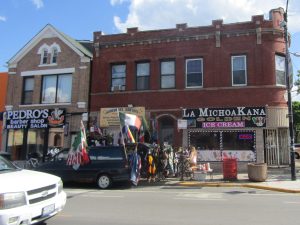
The Quality of Life Plan prioritizes legalizing street vendors, a major part of Little Village’s informal economy.
officials, and all three Little Village plans were no exception. Nunez said that they did an extensive outreach to make sure that every segment of the community’s population got to share feedback, including immigrants and local youth.
The 2024 plan is divided into “pillars,” the broad topic areas, with multiple goals and strategies for how to improve each pillar. Chronicle Media will focus on the major components of the plan.
Arts & Culture pillar
The plan emphasizes supporting artists, organizations and events that are already there. The plan calls for a centralized database of Little Village artists and cultural organizations to help get the word out about what they do and make it easier to connect to resources. The plan also calls for nurturing the next generation of artists, providing Little Village youth with career guidance and paid internship opportunities, and supporting events and activities that are either Spanish-only or use English and Spanish on equal footing.
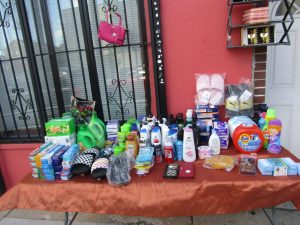 For the Economic Development pillar, the major priority is supporting local businesses by helping them with funding, whether it’s through local banks or government grants. Financial literacy and workforce development is another major component. The plan sets legalizing street vendors, a common sight throughout Little Village. To ensure that local businesses and residents benefit from major projects in the neighborhood, the plan calls for requiring Community Benefit Agreements or Memorandums of Understanding that would guarantee local hiring and contracting opportunities, as well as job training.
For the Economic Development pillar, the major priority is supporting local businesses by helping them with funding, whether it’s through local banks or government grants. Financial literacy and workforce development is another major component. The plan sets legalizing street vendors, a common sight throughout Little Village. To ensure that local businesses and residents benefit from major projects in the neighborhood, the plan calls for requiring Community Benefit Agreements or Memorandums of Understanding that would guarantee local hiring and contracting opportunities, as well as job training.
Education pillar
The plan calls for investing in daycares and other early childhood education providers. Increasing adult education opportunities, as well as promoting trade schools and investing in college readiness programs. The plan calls for “advocating for enhanced resources and protections” for students who are undocumented or asylum seekers and face legal obstacles citizens and permanent residents don’t.
Environment & Infrastructure pillar
The plan prioritizes making streets safer for pedestrians, cyclists and drivers, supporting tighter regulations on what streets the freight trucks can use, promoting green spaces, and requiring buildings to use more environmentally sustainable features.
Health pillar
The plan calls for developing and investing in community health providers that would be able to treat uninsured residents, including those who can’t qualify for Medicaid or Medicare due to their immigration status. It calls for hiring more Spanish-speaking healthcare workers at the existing providers and setting up a pipeline to train and place Little Village residents in area hospitals. The plan looks to build on collaborations that formed during the COVID-19 pandemic to make it easier to
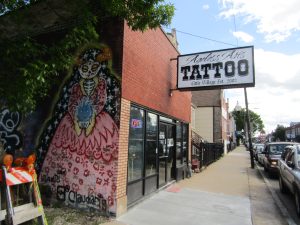
The Quality of Life Plan puts emphasis on supporting Little Village artists and business owners
refer families to local providers and disseminate information about the services that are available in both English and Spanish.
Housing pillar
The plan calls for creating a separate community plan that would look at what kind of housing Little Village residents need and work with community organizations and developers to make it happen. The plan also calls for teaching current and potential homeowners how to manage their money, reduce property taxes and be good landlords. Teaching renters and homeowners about existing federal and state resources is another major priority.
Immigration pillar
The major priorities include developing and improving welcoming center for new arrivals, encouraging collaboration between government agencies and nonprofits that work with immigrants on issues, creating support for affordable immigration-related legal services, and training asylum-seekers on how to advocate for themselves.
Safety pillar
The plan prioritizes trying to prevent crimes from happening in the first place and deescalating tense situations. The plan calls for investing and supporting the existing Community Violence Intervention strategies, which try to tackle root causes of crime and violence such as lack of jobs and mental health issues. Teaching residents, especially youth, how to solve conflicts constructively, without resorting to violence, is a major priority, and so is investing in domestic violence services for victims and perpetrators alike. The plan reasons that domestic violence is a symptom of other issues, and it makes sense to try to break the cycle by addressing them.
There are several goals that appear under more than one pillar — most notably, developing affordable housing, making sure mental health services accessible to as many people as possible, and supporting and spotlighting the cultures represented throughout Little Village through things like art projects and community events.
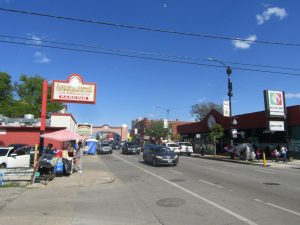
Little Village’s 26th Street corridor
The plan lists “pillar-level metrics” to measure how successful the strategies are. The Economic Development metrics, for example, will look at employment rates, the number of commercial vacancies, how many Little Village businesses are owned by locals, average household income and poverty rate.
The first Quality of Life Plan was developed in 2005, and the second was developed in 2013. Nunez said that the experience with previous plans taught them the importance of follow-through.
“We’re working on creating an infrastructure, so that we have a committee that will be working on the regular basis to see how we’re reaching the [metrics] and reaching the goals of the Quality of Life Plan,” he said.
He added that, because Enlace is part of the United Way of Metro Chicago’s Little Village neighborhood network, they will be able to work with other nonprofits and community stakeholders to “facilitate the ongoing review and evaluation of the plan.”
Nunez also said that they are working with AECOM engineering and consulting firm to help with the evaluation.
“We’re going to need to continue to work with 50-plus organizations and [officials] in our community, to be able to implement, as much as we can, the Quality of Life Plan,” he said
Read the full Little Village Quality of Life Plan here https://issuu.com/littlevillageqlp/docs/qlp_full_document_issuu







